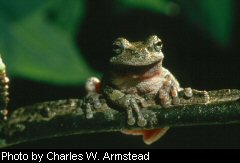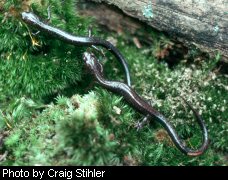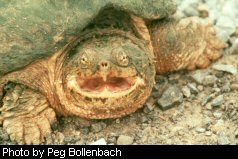

Warmer Weather Has Everyone Hoppin'By Jennifer Wykle
Through field research, biologists are trying to solve many questions and problems concerning herps . One question is very simple: Where do these species live? Documenting where species occur and understanding their distribution throughout West Virginia is one of the tasks of the West Virginia Wildlife Diversity Program of the Division of Natural Resources (DNR) which provides financial assistance for many research projects. The focus is placed on rare and federally threatened species such as the midland mud salamander, six-line racerunner , eastern ribbon snake and the Cheat Mountain salamander. Besides conducting various herp distribution surveys on public lands, frog call surveys and other projects, the best way to accomplish these tasks is collaborating with other researchers in the state. DNR personnel are currently working with Marshall University staff and students on a large scale effort to survey, document and publish data on all herps in West Virginia; a project known as the West Virginia Amphibian and Reptile Atlas. The Atlas project compiles over 70 years of data conducted at Marshall University, and is the largest source of herp information in the state. Dr. Thomas K. Pauley , the Mountain State's foremost herpetologist, has been the leader of this undertaking. As part of the project, Dr. Pauley and his students have been roaming the state, splashing in every stream, flipping over every log and even stopping to collect roadkills they find to “fill in the gaps” and document the distribution of herps in West Virginia. In doing this, they add to the N. Bayard Green Museum of Natural History at Marshall University, the only in-state museum of herps , with over 15,000 records. All of the herp museum data will soon be available online as a searchable database on the web. By compiling decades of herp data, biologists can determine population trends and where species may be declining. Information from Dr. Pauley's current and past projects will be included in the Atlas project and in the update of his and the late Dr. Bayard Green's book, Amphibians and Reptiles in West Virginia . Dr. Pauley has 12 graduate students working on a variety of projects with eight researching species rare to West Virginia. For example, last spring larvae for the spadefoot toad, which had not been seen in West Virginia since the 1960s, were found at two In addition to student projects, atlas surveys, museum work and braking to collect roadkill , one of Dr. Pauley's most important projects is assisting the DNR and the U.S. Fish and Wildlife Service with monitoring the Cheat Mountain salamander. This federally threatened species is found only in West Virginia and typically lives in cool, moist, red spruce forests. However, because most of the red spruce were cut by 1920, many populations today also occur in mixed deciduous forests. Since it was first described in the mid-1930s in Randolph County, the Cheat Mountain salamander's distribution has been expanded to the higher elevations of Randolph, Tucker, Pendleton , Pocahontas and Grant counties. New surveys for the salamander will be conducted on Snowshoe Mountain and Kumbrabow State Forest this year. Marshall University has also been involved with the North American Amphibian Monitoring Program (NAAMP), a nationwide effort to gather information on and monitor populations of calling frogs and toads. Volunteers drive predetermined routes and stop along roadsides, listening and recording the different species they hear. Gathering this information on these amphibians is especially important because they are good indicators of the ecosystem's overall health. Because they depend on water during all or most of their lives, an absence of frogs and toads may indicate a water quality problem. Professors at West Virginia University are also conducting various amphibian and reptile studies. Dr. Jim Anderson and his students are surveying the Ohio River and its backchannel areas for turtles, frogs and toads as well as evaluating frog and toad populations on mitigated and natural wetlands. They are also using habitat models to evaluate red spotted newt and snapping turtle habitats. Another student researcher, Amy Spurgeon , is finishing a two-year study documenting the herps at Camp Dawson , an Army Training Site in Preston County. She is comparing species abundance and diversity within the various habitat types located on the In addition to state agencies and universities, there are many private individuals who devote their time and expertise to herp studies such as Marty Martin from Harper's Ferry. He has been studying West Virginia's rattlesnakes for over 40 years and is one of the top rattlesnake biologists in the world. While many people run away from the sound of rattlers, Martin studies the rattlesnake's biology and behavior. He and other biologists are monitoring den sites here in West Virginia where populations appear stable, but are not immune from the threats that have almost completely wiped out the rattlesnake in the northeastern United States. Past, present and future research projects in West Virginia will document where these herps occur and determine why they are declining in so many areas. In the meantime, if you see strange two-legged creatures standing in the rain at night by a roadside pond, don't worry. Those biologists are out there to better understand West Virginia's extraordinary herp life. Jennifer Wykle is a zoologist with the DNR's Wildlife Diversity Program and stationed in Elkins. |
 What are herps ? Herps is the collective term used when talking about all amphibian and reptile species. West Virginia is home to more than 90 species and subspecies of salamanders, frogs, toads, lizards, skinks, turtles and snakes-a veritable herp paradise! Numerous biologists take interest in these animals and are conducting important projects right here in the Mountain State.
What are herps ? Herps is the collective term used when talking about all amphibian and reptile species. West Virginia is home to more than 90 species and subspecies of salamanders, frogs, toads, lizards, skinks, turtles and snakes-a veritable herp paradise! Numerous biologists take interest in these animals and are conducting important projects right here in the Mountain State.  sites in Wayne County. Marshall student Keith Johnson will be conducting research on this small, secretive toad which spends most of its life underground. Another student, Ariana Breisch , is finishing up her project studying two of the Mountain State's rarest turtles--the spotted turtle and the wood turtle in the eastern panhandle of West Virginia. Both of those species, which inhabit the wetlands of that region, are threatened by habitat alteration and poaching.
sites in Wayne County. Marshall student Keith Johnson will be conducting research on this small, secretive toad which spends most of its life underground. Another student, Ariana Breisch , is finishing up her project studying two of the Mountain State's rarest turtles--the spotted turtle and the wood turtle in the eastern panhandle of West Virginia. Both of those species, which inhabit the wetlands of that region, are threatened by habitat alteration and poaching.  base. Dr. Petra Wood and her students are comparing herp communities in mountaintop removal/valley fill mining landscapes to areas not impacted by mining.
base. Dr. Petra Wood and her students are comparing herp communities in mountaintop removal/valley fill mining landscapes to areas not impacted by mining.